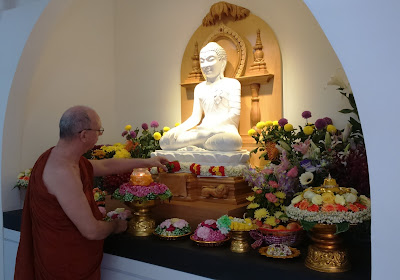This
year had not been a particularly busy one for me. It did however, mark two significant landmarks
in my life; I turned 65 in October and I celebrated 40 years of being a monk. I
made two overseas trips in the last twelve months. Together with a group of friends
I visited northern Queensland and when
they returned after a week I stayed behind for another two weeks. I spent July/August in France visiting family.
While there my brother and I visited St. Nazaire where the famous commando raid
took place during the Second World War. Over the last decade I have become
increasingly interested in the history of WWII, perhaps an unusual interest for
a monk. Our society had several prominent visitors this year. Bhante
Dhammaswami from Oxford was holed up in Singapore with a broken leg, having
fallen down in the Botanical Gardens. Bob Isaacson from Dharma Voice for
Animals in the US paid us a visit, and Ven. Anoma stayed with us for a month. My
Dhamma work received some recognition this year with the publication of Figures of Buddhist Modernity in Asia
published by the University of Hawaii Press which includes a paper about me by Meng Tat Chai. Other than this my
year has generally been quiet. Only one new book came out, A Pilgrim’s Guide to Borobudur was published in Jakarta in English
and Indonesian. I contributed an essay for the beautiful new coffee-table Sri Lanka: The Heritage of Water which
was published in Colombo just last month. I also finished my new book, A Banquet for the Buddha: Food and Drink in Early Historical India although it will not be published until
sometime next year. I decided to cut my
speaking engagements, only accepting several invitations to organizations that have been supportive of
our society over the years. Next year I plan to withdraw much more from public engagements
so I can focus on writing and meditation.
I
hope all my readers will have a happy, safe and fruitful New Year.





























